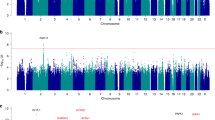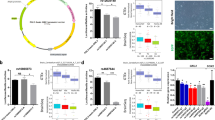Abstract
Epilepsy is a common neurological disease characterized by recurrent unprovoked seizures. Evidence suggested that abnormal activity of brain-derived neurotrophic factor (BDNF) contributes to the pathogenesis of epilepsy. Some previous studies identified association between genetic variants of BDNF and risk of epilepsy. In this study, this association has been examined in the Hong Kong and Malaysian epilepsy cohorts. Genomic DNA of 6047 subjects (1640 patients with epilepsy and 4407 healthy individuals) was genotyped for rs6265, rs11030104, rs7103411, and rs7127507 polymorphisms by using Sequenom MassArray and Illumina HumanHap 610-Quad or 550-Duo BeadChip arrays techniques. Results showed significant association between rs6265 T, rs7103411 C, and rs7127507 T and cryptgenic epilepsy risk (p = 0.00003, p = 0.0002, and p = 0.002, respectively) or between rs6265 and rs7103411 and symptomatic epilepsy risk in Malaysian Indians (TT vs. CC, p = 0.004 and T vs. C, p = 0.0002, respectively) as well as between rs6265 T and risk of cryptogenic epilepsy in Malaysian Chinese (p = 0.005). The Trs6265-Crs7103411-Trs7127507 was significantly associated with cryptogenic epilepsy in Malaysian Indians (p = 0.00005). In conclusion, our results suggest that BDNF polymorphisms might contribute to the risk of epilepsy in Malaysian Indians and Chinese.



Similar content being viewed by others
References
de Boer HM, Moshé SL, Korey SR, Purpura DP (2013) ILAE/IBE/WHO Global Campaign Against Epilepsy: a partnership that works. Curr Opin Neurol 26(2):219–225
Fargali S, Sadahiro M, Jiang C, Frick AL, Indall T, Cogliani V, Welagen J, Lin WJ et al (2012) Role of neurotrophins in the development and function of neural circuits that regulate energy homeostasis. J Mol Neurosci 48(3):654–659
Ichim G, Tauszig-Delamasure S, Mehlen P (2012) Neurotrophins and cell death. Exp Cell Res 318(11):1221–1228
Heinrich C, Lähteinen S, Suzuki F, Anne-Marie L, Huber S, Häussler U, Haas C, Larmet Y et al (2011) Increase in BDNF-mediated TrkB signaling promotes epileptogenesis in a mouse model of mesial temporal lobe epilepsy. Neurobiol Dis 42(1):35–47
Scharfman HE (2005) Brain-derived neurotrophic factor and epilepsy–a missing link? Epilepsy Curr 5(3):83–88
Scharfman HE (2002) Epilepsy as an example of neural plasticity. Neuroscientist 8(2):154–173
Kotloski R, McNamara JO (2010) Reduction of TrkB expression de novo in the adult mouse impairs epileptogenesis in the kindling model. Hippocampus 20(6):713–723
Unalp A, Bora E, Cankaya T, Giray Bozkaya O, Ercal D, Ozturk A, Ulgenalp A (2012) Lack of association of childhood partial epilepsy with brain derived neurotrophic factor gene. Sci World J 2012:414797
Tondo M, Poo P, Naudó M, Ferrando T, Genovés J, Molero M, Martorell L (2011) Predisposition to epilepsy in fragile X syndrome: does the Val66Met polymorphism in the BDNF gene play a role? Epilepsy Behav 22(3):581–583
Bragatti JA, Schenkel LC, Torres CM, Manfro GG, Blaya C, Souza AC, Souza DO, Saraiva-Pereira ML et al (2010) No major clinical impact of Val66Met BDNF gene polymorphism on temporal lobe epilepsy. Epilepsy Res 88(2–3):108–111
Lohoff FW, Ferraro TN, Dahl JP, Hildebrandt MA, Scattergood TM, O'Connor MJ, Sperling MR, Dlugos DJ et al (2005) Lack of association between variations in the brain-derived neurotrophic factor (BDNF) gene and temporal lobe epilepsy. Epilepsy Res 66(1–3):59–62
Chou IC, Tsai CH, Lee CC, Lin SS, Tsai FJ (2004) Brain-derived neurotrophic factor (BDNF) Val66Met polymorphisms in febrile seizures. Epilepsy Res 60(1):27–29
Kanemoto K, Kawasaki J, Tarao Y, Kumaki T, Oshima T, Kaji R, Nishimura M (2003) Association of partial epilepsy with brain-derived neurotrophic factor (BDNF) gene polymorphisms. Epilepsy Res 53(3):255–258
Berg AT, Berkovic SF, Brodie MJ, Buchhalter J, Cross JH, van Emde BW, Engel J, French J et al (2010) Revised terminology and concepts for organization of seizures and epilepsies: report of the ILAE commission on classification and terminology, 2005–2009. Epilepsia 51(4):676–685
Guo Y, Baum LW, Sham PC, Wong V, Ng PW, Lui CH, Sin NC, Tsoi TH et al (2012) Two-stage genome-wide association study identifies variants in CAMSAP1L1 as susceptibility loci for epilepsy in Chinese. Hum Mol Genet 21(5):1184–1189
Vigers AJ, Amin DS, Talley-Farnham T, Gorski JA, Xu B, Jones KR (2012) Sustained expression of brain-derived neurotrophic factor is required for maintenance of dendritic spines and normal behavior. Neuroscience 212:1–18
Greenberg ME, Xu B, Lu B, Hempstead BL (2009) New insights in the biology of BDNF synthesis and release: implications in CNS function. J Neurosci 29(41):12764–12767
Pruunsild P, Kazantseva A, Aid T, Palm K, Timmusk T (2007) Dissecting the human BDNF locus: bidirectional transcription, complex splicing, and multiple promoters. Genomics 90(3):397–406
Aid T, Kazantseva A, Piirsoo M, Palm K, Timmusk T (2007) Mouse and rat BDNF gene structure and expression revisited. J Neurosci Res 85:525–535
Egan MF, Kojima M, Callicott JH, Goldberg TE, Kolachana BS, Bertolino A, Zaitsev E, Gold B et al (2003) The BDNF val66met polymorphism affects activity-dependent secretion of BDNF and human memory and hippocampal function. Cell 112(2):257–269
Je HS, Yang F, Ji Y, Nagappan G, Hempstead BL, Lu B (2012) Role of pro-brain-derived neurotrophic factor (proBDNF) to mature BDNF conversion in activity-dependent competition at developing neuromuscular synapses. Proc Natl Acad Sci U S A 109(39):15924–15929
Nagappan G, Zaitsev E, Senatorov VV Jr, Yang J, Hempstead BL, Lu B (2009) Control of extracellular cleavage of ProBDNF by high frequency neuronal activity. Proc Natl Acad Sci U S A 106(4):1267–1272
Sonali N, Tripathi M, Sagar R, Vivekanandhan S (2013) Val66Met polymorphism and BDNF levels in Alzheimer's disease patients in North Indian population. Int J Neurosci 123(6):409–416
Borroni B, Bianchi M, Premi E, Alberici A, Archetti S, Paghera B, Cerini C, Papetti A et al (2012) The brain-derived neurotrophic factor Val66Met polymorphism is associated with reduced hippocampus perfusion in frontotemporal lobar degeneration. J Alzheimers Dis 31(2):243–251
Fehér A, Juhász A, Rimanóczy A, Kálmán J, Janka Z (2009) Association between BDNF Val66Met polymorphism and Alzheimer disease, dementia with Lewy bodies, and Pick disease. Alzheimer Dis Assoc Disord 23(3):224–228
Yu H, Zhang Z, Shi Y, Bai F, Xie C, Qian Y, Yuan Y, Deng L (2008) Association study of the decreased serum BDNF concentrations in amnestic mild cognitive impairment and the Val66Met polymorphism in Chinese Han. J Clin Psychiatry 69(7):1104–1111
He XM, Zhang ZX, Zhang JW, Zhou YT, Tang MN, Wu CB, Hong Z (2007) Lack of association between the BDNF gene Val66Met polymorphism and Alzheimer disease in a Chinese Han population. Neuropsychobiology 55(3–4):151–155
Tapia-Arancibia L, Rage F, Givalois L, Arancibia S (2004) Physiology of BDNF: focus on hypothalamic function. Front Neuroendocrinol 25(2):77–107
Murray PS, Holmes PV (2011) An overview of brain-derived neurotrophic factor and implications for excitotoxic vulnerability in the hippocampus. Int J Pept 2011:654085
Lähteinen S, Pitkänen A, Saarelainen T, Nissinen J, Koponen E, Castrén E (2002) Decreased BDNF signalling in transgenic mice reduces epileptogenesis. Eur J Neurosci 15(4):721–734
Chen ZY, Jing D, Bath KG, Ieraci A, Khan T, Siao CJ, Herrera DG, Toth M et al (2006) Genetic variant BDNF (val66met) polymorphism alters anxiety-related behavior. Science 314(5796):140–143
Bolton MM, Pittman AJ, Lo DC (2000) Brain-derived neurotrophic factor differentially regulates excitatory and inhibitory synaptic transmission in hippocampal cultures. J Neurosci 20(9):3221–3232
Sabeti PC, Schaffner SF, Fry B, Lohmueller J, Varilly P, Shamovsky O, Palma A, Mikkelsen TS et al (2006) Positive natural selection in the human lineage. Science 312(5780):1614–1620
Petryshen TL, Sabeti PC, Aldinger KA, Fry B, Fan JB, Schaffner SF, Waggoner SG, Tahl AR et al (2010) Population genetic study of the brain-derived neurotrophic factor (BDNF) gene. Mol Psychiatry 15(8):810–815
Zhang K, Calabrese P, Nordborg M, Sun F (2002) Haplotype block structure and its applications to association studies: power and study designs. Am J Hum Genet 71(6):1386–1394
Gkampeta A, Fidani L, Clarimón J, Kalinderi K, Katopodi T, Zafeiriou D, Pavlou E (2014) Association of brain-derived neurotrophic factor (BDNF) and elongator protein complex 4 (ELP4) polymorphisms with benign epilepsy with centrotemporal spikes in a Greek population. Epilepsy Res 108(10):1734–1739
Kim B, Kim CY, Hong JP, Kim SY, Lee C, Joo YH (2008) Brain-derived neurotrophic factor Val/Met polymorphism and bipolar disorder. Association of the Met allele with suicidal behavior of bipolar patients. Neuropsychobiology 58(2):97–103
Dorajoo R, Blakemore AI, Sim X, Ong RT, Ng DP, Seielstad M, Wong TY, Saw SM et al (2012) Replication of 13 obesity loci among Singaporean Chinese, Malay and Asian-Indian populations. Int J Obes (Lond) 36(1):159–163
Hall D, Dhilla A, Charalambous A, Gogos JA, Karayiorgou M (2003) Sequence variants of the brain-derived neurotrophic factor (BDNF) gene are strongly associated with obsessive-compulsive disorder. Am J Hum Genet 73(2):370–376
Ribasés M, Gratacòs M, Armengol L, de Cid R, Badía A, Jiménez L, Solano R, Vallejo J et al (2003) Met66 in the brain-derived neurotrophic factor (BDNF) precursor is associated with anorexia nervosa restrictive type. Mol Psychiatry 8(8):745–751
Chang YH, Lee SY, Chen SL, Tzeng NS, Wang TY, Lee IH, Chen PS, Huang SY et al (2013) Genetic variants of the BDNF and DRD3 genes in bipolar disorder comorbid with anxiety disorder. J Affect Disord 151(3):967–972
Wang Z, Li Z, Chen J, Huang J, Yuan C, Hong W, Yu S, Fang Y (2012) Association of BDNF gene polymorphism with bipolar disorders in Han Chinese population. Genes Brain Behav 11(5):524–528
Geller B, Badner JA, Tillman R, Christian SL, Bolhofner K, Cook EH Jr (2004) Linkage disequilibrium of the brain-derived neurotrophic factor val66met polymorphism in children with prepubertal and early adolescent bipolar disorder phenotype. Am J Psychiatry 161(9):1698–1700
Cheah SY, Lawford BR, Young RM, Connor JP, Phillip Morris C, Voisey J (2014) BDNF SNPs Are Implicated in Comorbid Alcohol Dependence in Schizophrenia But Not in Alcohol-Dependent Patients Without Schizophrenia. Alcohol Alcohol 49(5):491–497
Li W, Zhou N, Yu Q, Li X, Yu Y, Sun S, Kou C, da Chen C et al (2013) Association of BDNF gene polymorphisms with schizophrenia and clinical symptoms in a Chinese population. Am J Med Genet B Neuropsychiatr Genet 162B(6):538–545
Neves-Pereira M, Cheung JK, Pasdar A, Zhang F, Breen G, Yates P, Sinclair M, Crombie C et al (2005) BDNF gene is a risk factor for schizophrenia in a Scottish population. Mol Psychiatry 10(2):208–212
Haerian BS (2013) BDNF rs6265 polymorphism and drug addiction: a systematic review and meta-analysis. Pharmacogenomics 14(16):2055–2065
Govindarajan A, Rao BS, Nair D, Trinh M, Mawjee N, Tonegawa S, Chattarji S (2006) Transgenic brain-derived neurotrophic factor expression causes both anxiogenic and antidepressant effects. Proc Natl Acad Sci U S A 103(35):13208–13213
Acknowledgments
We gratefully acknowledge subjects from Malaysia and Hong Kong for their participation in this study, as well as the staff of the hospitals for their assistance in recruiting patients.
Compliance with Ethical Standards
ᅟ
Funding
This study was funded by Malaysian Grants HIR MOHE E000025-20001 and RG 520/13HTM and grants HKU7623/08 M, HKU7747/07 M and CUHK4466/06 M from the Research Grants Council of the Hong Kong Special Administrative Region, China.
Conflict of Interest
The authors declare that they have no conflict of interest.
Author information
Authors and Affiliations
Corresponding authors
Additional information
Hidayati Mohd Sha’ari, Batoul Sadat Haerian and Larry Baum contributed equally to this work.
Rights and permissions
About this article
Cite this article
Sha’ari, H.M., Haerian, B.S., Baum, L. et al. Association of BDNF Polymorphisms with the Risk of Epilepsy: a Multicenter Study. Mol Neurobiol 53, 2869–2877 (2016). https://doi.org/10.1007/s12035-015-9150-1
Received:
Accepted:
Published:
Issue Date:
DOI: https://doi.org/10.1007/s12035-015-9150-1




